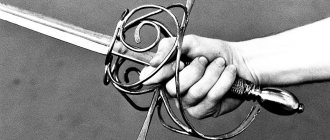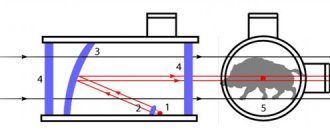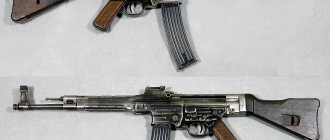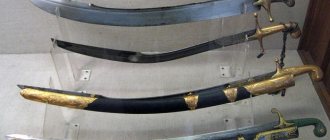On the Antik1941 website you will find rare antique examples of collectible weapons from Japan and Eastern countries. All items are, as a rule, in good collectible condition and have a clear attribution based on the time of production and distinctive features. Historical information about weapons, photographs chronicling the war years, articles about manufacturers - you can find all this in the product cards of our catalog. After all, collectibles are not just a product, but a piece of history, an object for study, and each item is unique in its own way...
Original Japanese edged weapons for collection and as a gift
Collectible antiques, military rarities and trophies of past warriors are always in a special place among connoisseurs of antiquities and antiques. And such people have been and will always be. Collections of captured weapons decorated both the chambers of the Roman patricians and the castles of the crusaders.
In Russia, collecting unusual ancient things became especially popular under Emperor Peter the First in the 18th century, who himself strongly supported the import of unusual artifacts into Russia. It is worth noting that already under Peter the import of rarities and antiquities was not subject to taxes; on the contrary, it was encouraged. Among the noble class, collecting has become ubiquitous; the foundations of museum collections such as the Pushkin Museum and the Hermitage Museum consist precisely of private collections collected in the 18th and 19th centuries. Here is a very revealing text from the book “Moscow and Muscovites” - a book by Vladimir Gilyarovsky, describing the traditions, life and customs of Moscow in the second half of the 19th - early 20th centuries. In particular, here is a description of a typical noble estate: “There was also a room: “dead room.” This is the most cheerful room, illuminated by a dark red lantern from the ceiling. Along the walls are various fossil mound antiquities, whole plateaus of ancient earrings and rings, weapons - dating back to the Stone Age - chain mail, helmets, reeds, scimitars. Along the walls there are wide Turkish sofas, in front of them there are tables with matches and ashtrays, and a hookah for amateurs. They sit, laugh, chat incessantly... Someone is strumming a balalaika, someone is dozing. And they called it “dead” because in the morning those who drank too much or who were very far from home usually slept on these sofas...”
You can collect anything. If we consider collectible artifacts in the context of military paraphernalia, then we must pay tribute, first of all, to genuine collectible weapons. In this section you will find collectible edged weapons from Japan, Asia and the East. Original bayonets, sabers, katanas and daggers.
Collectibles: Melee Weapons
Any real man will appreciate a real collectible weapon as a gift. Collectible military weapons carry a special energy. World War II collectibles are particularly attractive in this regard. Edged weapons (daggers, sabers and broadswords), MMGs (deactivated firearms), weapon accessories and equipment of this time are an indicator of the level of development of military production of a particular power, the personification of the technical level and scientific potential, since it is military technologies that are always one step ahead civilian Products “with history”, displayed in a glass display case, can become an original decoration of the restaurant hall. Antiques from Japan will be the best gift for a collector or someone who is interested in the traditions and customs of the Land of the Rising Sun.
Genuine antique products in the online store Antik1941
An effective interior decoration can be either an antique Japanese weapon, an amazing screen or an ancient engraving.
The latter, with images of samurai, geisha, courtesans or kabuki actors, will turn out to be a stylish accent in the design of the room. A screen with an exotic pattern will not only be beautiful, but also a functional interior detail, since its use will allow you to change the layout of the room in a matter of minutes.
Our store ANTIK1941, in addition to antique edged weapons and samurai armor, offers the purchase of household and interior items.
Our gallery offers to order not only Japanese antique swords, but also other products, for example, varnished or netsuke.
Small figurines can attract good luck, happiness, wealth, success and wisdom, and are an excellent gift option for a business partner. Both men and women will appreciate an elegant lacquered box, tray or stand for swords.
LiveInternetLiveInternet
- Fighting rings. Georgians are Khevsurs. 19th century. Metal 2. Fragment of a flintlock gun 3. Bebut dagger “Hanjali” with sheath. Georgians. Telavi district Tiflis province. Late 19th century. Steel, silver, bone, horn, wood, leather; grinding, brass notching, etching, engraving, niello, graining, false graining. 4. Saber with scabbard. Mingrelian Georgians. Second half of the 19th century. Steel. Brass, silver. Leather; grinding, engraving, stamping. The blade has the stamp “gourde” stamped on the right side 5. Broadsword with scabbard. Georgians-Khevsurs. 19th century. Steel, wood, leather, brass; grinding, stamping, engraving. On both sides of the blade there is a mark “GENOVA”
- Dagger - kama in a sheath with a dagger knife. Kubachi residents. Dagestan, p. Kubachi. Second half of the 19th century. Steel, silver, wood, bone, horn. 2. Shotel. Abyssinians. 19th century. Steel, horn; grinding. 3. Saber in sheath. Turks. 19th century. Steel, base metal, silver. 4. Checker People unknown. North Caucasus. First half to mid-19th century. Steel, silver. On the lugs of the handle inside, on the right there is an inscription in Arabic script “Owner Aga Khan”, on the left - “Made by Ibrahim” 5. Saber with scabbard. Laks. Early 20th century. Steel. Silver, wood, leather. The blade has an image of a dragon engraved on the left side, a crescent moon, stars and an inscription in Persian on the right side: “Made by Shakir Dagesradan. May the blade be invincible. Khanashir" 6. Kama dagger in sheath. Kabardians. Early 20th century. Steel, horn, leather, silver.
Dagger – kama with scabbard, first half of the 19th century. Steel, silver, bone, wood, leather, galloon; polishing, engraving, niello, filigree, false graining. On the front side of the handle, on a silver plate, there is an inscription in Arabic script: “Death and glory are enough for you, O mullah!” and the date “1243” (1827/28); on the back side of the bone is scratched the inscription “1849 December 20 x R.S.” Weapons from the collection of artillery general, military historian, creator of the first regimental museum in Russia, full member of the Imperial Military Historical Society Pavel Platonovich Pototsky (1857-1938)
Bebut dagger in a children's scabbard from Kubachi. Dagestan, p. Kubachi. Second half of the 19th century. Steel, wood, horn, morocco, galloon; grinding, bluing, gold notching.
Bebut dagger in sheath. Iranians. First part of the 19th century. Steel, copper, polishing, gold incision, embossing, enamel.
Bebut dagger with scabbard. Iranians. 19th century. Steel, silver, ivory, wood, fabric; grinding, gold notching, stamping, engraving, granulation, bone carving. On the handle in cartouches there is an inscription in Arabic script “Speech in the name of Allah bears fruit (...). There is no god but Allah. He who glorifies Allah is the glory of Allah."
1. Whip. Ossetians. 19th century. Wood, silver, galloon, leather. 2. Kama dagger with sheath. Kabardians. Tersk region Late 19th – early 20th century. Steel, silver, bone. Tree; grinding, engraving, niello, false graining, gilding, silver incision. Collector Z.P. Valeev. 1907 On the front side of the blade there is an engraving design with a stylized floral pattern, a grid, dots and an image of a double-headed eagle. On the back there is a stylized floral pattern and dots. Similar decoration of blades is typical for the village of Bolshiye (Old) Atagi. 3. Checker The people are unknown. North Caucasus. Mid 19th century. Steel, silver; polishing, engraving, niello, filigree, false graining, gilding. On both sides near the handle there is an engraved geometric and stylized floral pattern. 4. Checker The people are unknown. North Caucasus. Mid 19th century. Steel, silver; polishing, engraving, niello, filigree. On the left side of the blade is the mark “Transylvanian Knot”
Uzbek knife. First half of the 19th century. Steel, silver, horn, turquoise; polishing, engraving, gilding.
Clubs. Iran.
“Elite weapons. Iranians Iran occupies a special place in the Near and Middle East. The political and cultural influence that Iran had on its surrounding states was enormous. It was here that, back in the Middle Ages, the principles of military art were systematized and formulated, which were reflected in the military affairs of Byzantium, Transcaucasia and Central Asia. Acting as a trendsetter in the field of military culture, Iran has long produced standard models of weapons and weapons, which they tried to imitate outside Western Asia. However, the quality of analogues was often inferior to the originals, since the artisans who were part of the guild associations tried to keep secret the secrets of making weapons. Therefore, weapons, in particular saber blades, produced in the weapons centers of Iran, for example in Isfahan, were especially valued throughout the East and among weapons experts in Modern Europe.”
Saber with scabbard. Uzbeks. Bukhara. Late 19th century. Steel, base metal, gold, silver, wood, turquoise, silk cord; grinding, gold notching, stamping, engraving, filigree. From the gifts of the emirs of Bukhara to the Russian Imperial family.
Hatchet “Ai-Balta” Uzbeks. Bukhara. Late 19th century Steel, gold, silver, wood, turquoise; grinding, engraving, gold notching, embossing, false graining. From the gifts of the emirs of Bukhara to the Russian Imperial family.
Helmet with a mask and chain mail aventail. North Caucasus.
Bebut dagger “Khanjali” with scabbard. Georgians. Telavi district Tiflis province. Late 19th century. Steel, silver, bone, horn, wood, leather; grinding, brass notching, etching, engraving, niello, graining, false graining.
Saber and broadsword handles. Saber - Mingrelian Georgians. Second half of the 19th century. Steel. Brass, silver. Leather; grinding, engraving, stamping. The blade has the stamp “gourde” stamped on the right side. Broadsword - Georgians-Khevsurs. 19th century. Steel, wood, leather, brass; grinding, stamping, engraving. On both sides of the blade there is a mark “GENOVA”
Checker. Uzbeks. Late 19th century. Steel, brass, engraving, gilding.
Georgian-Gurian flintlock gun. First half of the 19th century. Gift of the Russian Geographical Society. 3. Scimitar with scabbard Turki. First quarter of the 19th century. Steel, horn, leather; grinding, silver notching, embossing, embossing. There are inscriptions on the blade in Turkish (with errors). On the left side: "Muhammad Ali"; on the right is the date: “1234” AH. (1818/19) and the inscription “Owner Ali” 4. Scimitar with scabbard. Iranians, Turks. First half of the 19th century. Steel, silver, bone, wood; grinding, notching, stamping, engraving. On the left side of the blade there is an inscription in Arabic script “As Allah wills. Umar did it. Owner Yusif Kabudan. 1253. Start the battle...” on the right side "Let the sword be invincible"
www.knifelife.ru/misc_vystavka.htm











